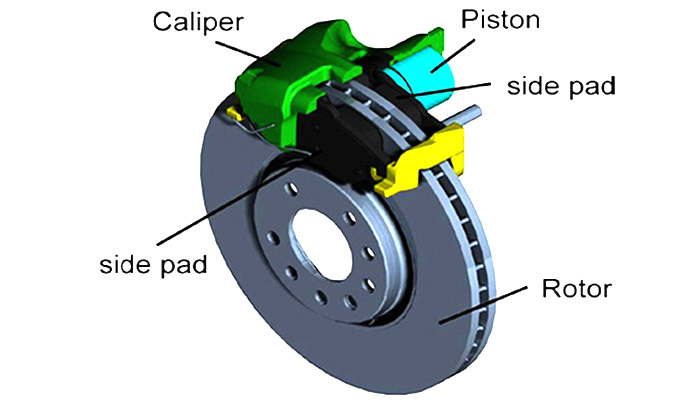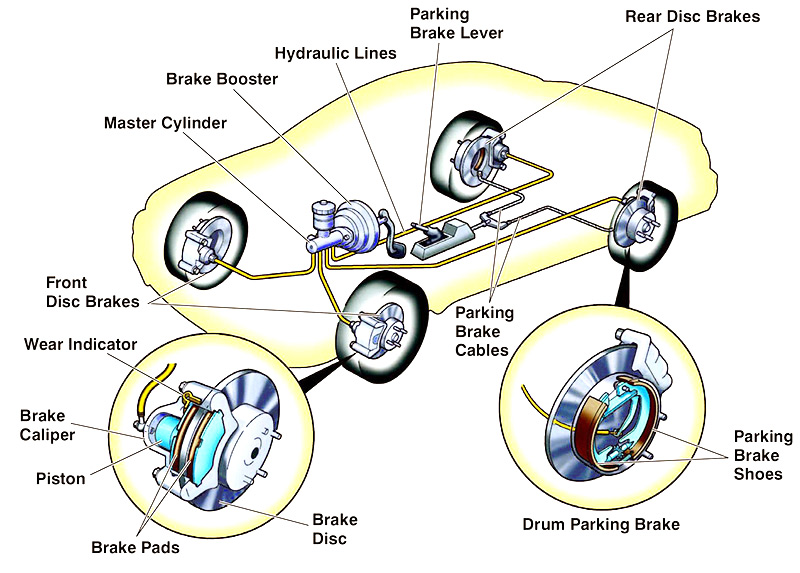COMMON BRAKES
 Typical automotive brake system has been refined and has become extremely dependable and efficient. Common brake system consists of disk brakes in front and either disk or drum brakes in the rear connected by a system of tubes and hoses that link the brake at each wheel to the master cylinder.
Typical automotive brake system has been refined and has become extremely dependable and efficient. Common brake system consists of disk brakes in front and either disk or drum brakes in the rear connected by a system of tubes and hoses that link the brake at each wheel to the master cylinder.Other systems that are connected with the brake system include: parking brakes, hydraulic lines, power booster and ABS the Anti-Lock system.
 Disc brakes assembly
Disc brakes assemblyDisc brakes convert the forward motion of the vehicle into heat, the friction surfaces of the pads on a disk brake system, or the shoes on a drum brake convert the forward motion of the vehicle into heat. Heat is what causes the friction surface lining of the pads or shoes to eventually wear out.
The lifespan of the common brake components depends on the type of pads and rotors, and of the driving habit. Car manufacturers and mechanics agree that brake pads typically last approximately 30,000 miles - 48,000 km. On average brake pads have to be replaced every 2 years, for city driving. Brake rotors can last quite a bit longer, as much as 3 times as long as pads.
 Hydraulic brakes system
Hydraulic brakes systemA typical brake system consists of disk brakes in front and either disk or drum brakes in the rear connected by a system of tubes and hoses that link the brake at each wheel to the master cylinder.
When the driver steps on the brake pedal, he is actually pushing against a plunger in the master cylinder, which forces brake fluid through a series of tubes and hoses to the braking unit at each wheel.
• Disk Brakes (at front and rear) fluid from the master cylinder is forced into a caliper where it presses against a piston. The piston squeezes two brake pads against the rotor which is attached to the wheel, forcing the vehicle to slow down or stop.
• Drum Brakes (at rear) fluid is forced into the cylinder, which pushes the brake shoes out so that the friction linings are pressed against the drum, attached to the wheel, causing the vehicle to slow down or stop.
Hydraulics brakes pros & cons:
Pros:
• Very dependable and efficient
• Easy replacement and maintenance
• Broadly used
Cons:
• Long response time
• Vibration, roughness and fraction noises
• Heavy weight, typical ABS disc brake system weighs about 80 kg
• Require power booster
• Require maintenance and periodic parts replacement
• Relatively short lifespan of the brake linings. Pads typically last 30,000 miles - 48 000 km on average
• Brake pads wear contributes to non-exhaust air pollution, airborne brake wear particles have been recognized as dangerous for human health.
Pros:
• Very dependable and efficient
• Easy replacement and maintenance
• Broadly used
Cons:
• Long response time
• Vibration, roughness and fraction noises
• Heavy weight, typical ABS disc brake system weighs about 80 kg
• Require power booster
• Require maintenance and periodic parts replacement
• Relatively short lifespan of the brake linings. Pads typically last 30,000 miles - 48 000 km on average
• Brake pads wear contributes to non-exhaust air pollution, airborne brake wear particles have been recognized as dangerous for human health.